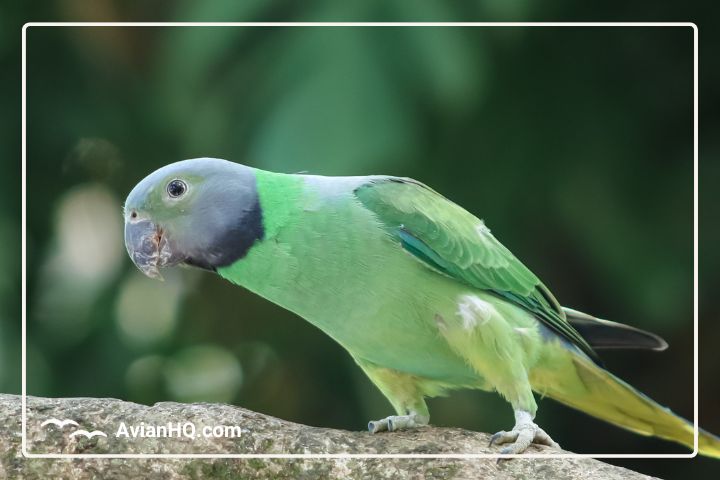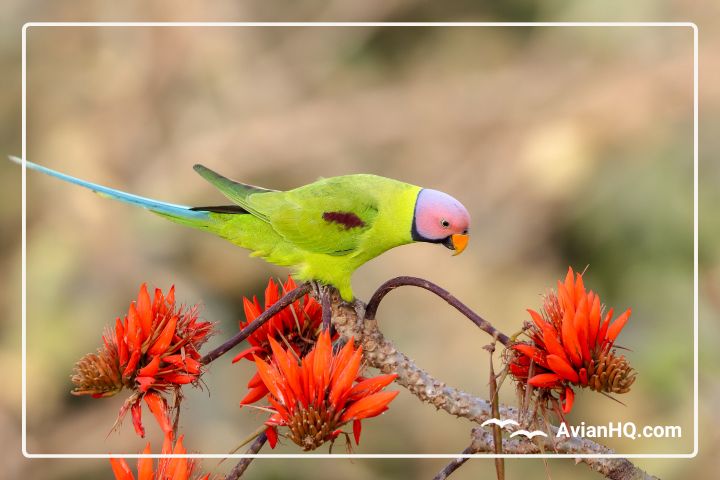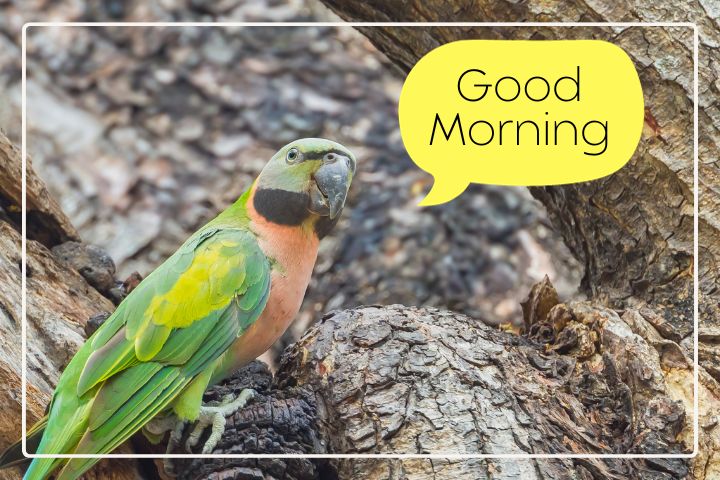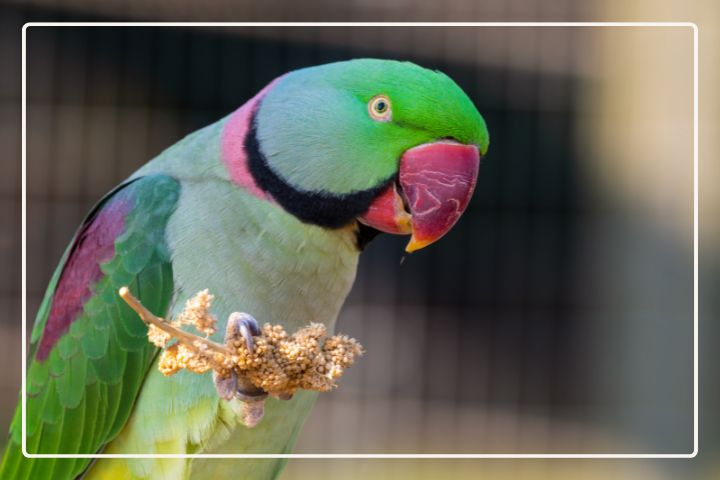Layard’s Parakeet: Overview, Characteristics and Care
Layard’s Parakeet, sometimes called an Emerald-collared Parakeet is a vibrant bird species found in Sri Lanka, known for its colorful plumage and distinct personality. These parakeets are popular among bird enthusiasts for their unique physical characteristics, social behavior, and playfulness.
The natural habitat of Layard’s Parakeet includes the lowland rainforests, wetlands, and agricultural lands of Sri Lanka. These parakeets have a diverse diet, feeding on a variety of fruits, seeds, and crops.
Although Layard’s Parakeet is not classified as an endangered species, its population has declined significantly in recent years due to habitat loss and poaching. It is crucial to protect this species to maintain ecological balance and prevent loss of biodiversity.
Key Takeaways:
- Layard’s Parakeet is a colorful bird species found in Sri Lanka.
- They primarily inhabit lowland rainforests, wetlands, and agricultural lands of Sri Lanka.
- They have a diverse diet consisting of fruits, seeds, and crops.
- Conservation efforts are crucial to protect this species from habitat loss and poaching.
- Protecting Layard’s Parakeet is essential for maintaining ecological balance and biodiversity.
Physical Characteristics of Layard’s Parakeet
Layard’s Parakeet is a medium-sized parakeet species that displays a striking combination of colors. The species has a predominantly green body with a yellow-green head, blue primary feathers, and a red beak.
One of the distinguishing features of this species is the black band that runs across their eyes and the red patch on their shoulders, which makes them easily recognizable. The average size of this species ranges from 28 to 30 cm (11 to 12 inches) in length, with a tail up to 13 cm (5 inches) and a weight of between 95 and 110 grams (3.35 to 3.9 oz).
They have strong, hooked beaks that they use to crack open seeds, nuts, and fruits. Their feet are zygodactyl, meaning they have two toes pointing forward and two pointing backward, which helps them climb trees, perch, and hold food while eating.
Behavior and Social Structure of Layard’s Parakeet
Layard’s Parakeet is a social and active bird species, often seen in small flocks in the wild. They are diurnal, meaning they are active during the day and sleep at night. These parakeets have a wide range of vocalizations that they use to communicate with each other. Their calls range from soft chirps to loud, high-pitched screeches.
Layard’s are omnivore, feeding on a variety of foods, including fruits, seeds, flowers, and insects. They are known for their acrobatic feeding behavior, often hanging upside down from branches to reach their desired food sources. They also use their powerful beaks to crack open nuts and seeds.
These parakeets have a highly developed sense of sight and are very alert to their surroundings. They use their keen eyesight to locate predators and other potential threats and will make loud alarm calls to warn their flock mates of danger.
Feeding Habits
Layard’s Parakeet is known to be a messy feeder, often dropping pieces of food on the ground while eating. This messy behavior is vital for the ecosystem, as dropped seeds can sprout and grow into new plants. These parakeets are also important pollinators, spreading pollen as they feed on flowers.
Interaction with Other Members of the Species
Layard’s Parakeet is a monogamous species, meaning they form long-term pair bonds with a single mate. These parakeets are very social and often groom each other as a form of bonding. They are also known to engage in play behavior, such as flying and chasing each other in the air.
During the breeding season, male parakeets will perform courtship displays, such as bowing and bobbing their heads, to attract a female mate. Once paired, the male and female will work together to build a nest, usually in a tree cavity or a hollow bamboo stem.
The behavior and social structure of Layard’s Parakeet make them fascinating and unique birds worth studying and protecting.
Layard’s Parakeet Habitat and Distribution
Layard’s Parakeet is a unique bird species native to Sri Lanka, where it inhabits a variety of ecosystems across the island. These birds prefer lowland forests, dense woodlands, and marshy areas, where they can find abundant food and shelter.
Their natural habitat is threatened by deforestation and human encroachment, which has resulted in a decline in their population numbers. However, conservation efforts are underway to protect their natural habitat and ensure their survival.
Layard’s Parakeets prefer to live in small flocks, and their distribution on the island varies depending on the availability of food and shelter. They are most commonly found in the southern and central regions of Sri Lanka, where the climate is suitable for their survival.
| Common Name | Layard’s Parakeet |
|---|---|
| Scientific Name | Psittacula calthropae |
| Length | Approximately 33 to 36 cm (13 to 14 inches) |
| Weight | 95 and 110 grams (3.35 to 3.9 oz) |
| Distribution | Southern and central regions of Sri Lanka |
| Habitat | Lowland forests, dense woodlands, and marshy areas |
Protecting the natural habitat of Layard’s Parakeet is crucial for their survival. The conservation efforts are targeted at reducing deforestation, stopping illegal hunting, and limiting human encroachment into their natural habitat. These efforts are essential to ensure the survival of this beautiful and unique bird species for future generations to appreciate and enjoy.
Diet and Feeding Patterns of Layard’s Parakeet
Layard’s Parakeet has a specialized diet that primarily consists of seeds, nuts, berries, and fruits. They have strong beaks that can crack open hard-shelled seeds and nuts, making these food sources an essential part of their diet.
In their natural habitat, Layard’s Parakeet forages for food in small groups, using their keen eyesight and acute hearing to locate food sources. Additionally, they may feed on cultivated crops like paddy, maize, and sunflower.
It is essential to replicate these dietary preferences in captivity to ensure the health and well-being of Layard’s Parakeet. A diet that is high in fat and protein, with a variety of fruits and vegetables, can help maintain their overall health. It is crucial to avoid feeding them with toxic foods, like chocolate and caffeine, which can be fatal and cause severe illness in birds.
To encourage their natural feeding habits, it is recommended to place a variety of perches and feeding stations in their enclosure. This provides mental stimulation and prevents boredom, ensuring they are mentally and physically stimulated.
Reproduction and Breeding of Layard’s Parakeet
Layard’s Parakeets are monogamous birds that form strong pair bonds during breeding season, which lasts from January to April. Their courtship rituals involve the male performing acrobatic displays, such as hanging upside down from branches and rapidly flapping his wings, to impress the female.
Once a pair has bonded, they will select a suitable nesting site, which is typically a hole in a tree trunk. The female will lay a clutch of three to four eggs, which she will incubate for around 23 days. During this time, the male will bring her food and water to sustain her.
Once the eggs hatch, both parents will care for the chicks. The young birds will fledge at around 35 days old, but they will stay with their parents for several weeks after leaving the nest before becoming independent.
Breeding success can be challenging for Layard’s Parakeets due to habitat loss and nest predation by invasive species such as rats and snakes. As a result, conservation efforts to protect their natural habitat and control invasive predators are crucial for the survival of this species.
By understanding the breeding habits and challenges of Layard’s Parakeets, we can better appreciate the importance of protecting their population and ensuring their continued existence for generations to come.
Lifespan and Predators of Layard’s Parakeet
In the wild, Layard’s Parakeets live about 15-20 years on average. This is much less than the 25 years they can live with proper care from humans. Many threats in their natural home cut their lives short.
These little, colorful birds have lots of predators trying to eat them. Snakes love to sneak into nests and eat eggs and baby birds. A kind of pit viper especially likes to munch on birds in trees. Grown up parakeets get attacked by hawks and eagles. The parakeets’ bright green coloration, which helps them blend into their natural surroundings, also makes them vulnerable to predators.
Cats and rats introduced to the ecosystem also feed on Layard’s Parakeets opportunistically. The Common Palm Civet, an agile tree-dwelling mammal, is another potential predator. Even the Sri Lankan Brown Mongoose could prey on fledglings or injured birds that end up on the forest floor.
Disease and parasites also shorten the lifespan of wild Layard’s Parakeets. Avian malaria is a huge concern, transmitted by infected mosquitoes. Endoparasites like the intestinal Cryptosporidium protozoan can also be fatal.
Human activities such as habitat destruction, hunting, and trapping also pose significant threats to their population.
Conservation Efforts for Layard’s Parakeet
The Layard’s Parakeet is considered an endangered species due to habitat loss, poaching, and climate change. With an estimated population of only a few thousand left in the wild, urgent conservation efforts are needed to protect this species.
The Department of Wildlife Conservation in Sri Lanka has designated protected habitats like the Sinharaja Forest Reserve and established conservation programs such as artificial nesting sites. The Sri Lanka Wildlife Conservation Society has also been involved in research and conservation initiatives.
Individuals can support conservation efforts by avoiding the purchase of illegally traded parakeets, and supporting organizations working to preserve the species. It is critical that action continues to protect the natural habitat of Layard’s Parakeet to ensure their survival.
The species is listed as endangered by the IUCN, with the major threats being habitat loss and fragmentation. Conservation measures in place include habitat restoration, captive breeding programs, and public awareness campaigns driven by the Department of Wildlife Conservation.
Population Numbers and Trends
Layard’s Parakeet has suffered a drastic decline in population over the past few decades. Deforestation and trapping pressures have decimated their numbers, now estimated between 1,000 – 2,500 individuals in the wild.
This represents a greater than 50% reduction from an estimated historical population of 5,000 – 10,000 parakeets in the 1980s. Their range has also diminished by over 30%, now fragmented and restricted to a few isolated pockets in southern Sri Lanka.
The largest extant populations are found in Sinharaja Forest Reserve and Kanneliya Forest Reserve, each hosting 500 – 1,000 birds. Smaller groups of less than 100 individuals exist in Bundala National Park, Yala National Park and Wirawila Forest Reserve.
With an estimated global population of 2,500 or less mature individuals, limited range and continuing pressures, Layard’s Parakeet is classified as Endangered on the IUCN Red List. Captive breeding programs have been initiated, with around 300 parakeets in aviaries, but reintroduction efforts have so far been unsuccessful.
The outlook remains bleak for the wild Layard’s Parakeet population without concerted conservation efforts. With low reproductive rates, their numbers could dwindle rapidly. Habitat protection and community engagement provide a lifeline to revive the population of this iconic parakeet species.
With coordinated efforts between wildlife agencies and public support, there is hope that Layard’s Parakeet can be saved from extinction.
Poaching
One major threat driving the decline of Layard’s Parakeet is poaching for the pet trade. These brightly colored parakeets are highly sought after by illegal collectors. Each year, trappers take hundreds of Layard’s Parakeets from the wild using snares, nets, and lime sticks. The young chicks are particularly vulnerable to poaching, as they have not yet learned to avoid traps.
Once captured, the parakeets are smuggled out of the country and sold on the black market for high prices as exotic pets. Removing so many individuals from an already fragile population makes it difficult for Layard’s Parakeet numbers to recover. Stricter law enforcement and crackdowns on poaching networks are critical to stop this threat and protect Layard’s Parakeet in the wild.
If you choose to acquire a Layard’s Parakeet as a companion, it is crucial to ensure that you are purchasing a healthy bird from a reputable breeder, regardless of their location. This can be done by researching and finding a breeder with a good reputation, whether they are local or not.
Essential Care Tips for Layard’s Parakeet
Layard’s Parakeet is a unique and vibrant bird species that requires proper care and attention to thrive in captivity. Here are some essential tips for taking care of your pet parakeet:
| Aspect of Care | Tips |
|---|---|
| Diet | Provide a well-balanced diet consisting of seeds, fruits, vegetables, and small amounts of protein-rich foods. Avoid feeding your parakeet foods that are high in fat, salt, or sugar. Fresh water should be available at all times. |
| Housing and Environment | Ensure that your parakeet has a spacious cage, with enough room to move around, stretch its wings, and play with toys. The cage should be placed in a well-lit and ventilated area, away from direct sunlight, drafts, and busy areas. Provide perches, toys, and other forms of mental stimulation to prevent boredom. |
| Grooming and Hygiene | Regularly trim your parakeet’s nails and beak to prevent overgrowth. Provide a shallow dish of water for your parakeet to bathe in at least once a week. Clean the cage and accessories regularly, and make sure to replace the bedding material as needed. |
| Interaction and Training | Parakeets are social birds that require interaction and attention from their owners. Spend time with your parakeet every day, talking and playing with it. Use positive reinforcement techniques to train your parakeet to step on your finger, come when called, or perform other simple tricks. |
By following these basic care tips, you can ensure that your Layard’s Parakeet remains healthy, happy, and well-adjusted in its new home.
Local Folklore and Cultural Associations
Layard’s Parakeet holds a special place in Sri Lankan culture and folklore. Known locally as the Sudu Rathu Miniketaya, it is considered the national bird of Sri Lanka.
The parakeet’s vibrant plumage has inspired many myths and legends over the centuries. According to folklore, the red beak signifies the blood shed by ancient warriors who fought to protect the land. The distinctive black eye-stripe represents the watchful eyes of Buddhist monks meditating in the forests.
In Sinhala poetry and music, the parakeet is a symbol of unity and harmony. One traditional folk song describes the parakeet’s green feathers as the different ethnic groups living together in peace.
During Avurudu, the Sinhala New Year, these parakeets are believed to bring good fortune. Their excited squeals are thought to mark a prosperous new beginning. Families often release caged parakeets back into the wild during the festivities, a practice considered to spread joy.
Featured prominently on stamps, currency, and insignia, the parakeet is intertwined with Sri Lanka’s cultural identity. While modernization threatens their survival, the Sudu Rathu Miniketaya continues to be an indelible part of the nation’s living heritage. From ancient mythology to Avurudu celebrations, Layard’s Parakeet remains an iconic symbol of Sri Lankan culture today.
Fascinating Facts about Layard’s Parakeet
If you’re a fan of Layard’s Parakeet, you might find these interesting tidbits about the species:
- Named after the British zoologist Edgar Leopold Layard, Layard’s Parakeet is also known as the Crimson-fronted Parakeet.
- These birds can live up to 15-20 years in captivity.
- While they are sociable birds, they are monogamous and tend to mate for life.
- Layard’s Parakeet is one of the few parakeet species that are not sexually dimorphic, meaning that males and females look alike.
- They are excellent climbers and can easily scale trees to reach food sources and nesting sites.
- Layard’s Parakeet has cultural significance in Sri Lanka, where it is considered a national symbol and has been featured on postage stamps.
- These birds can imitate sounds and even human speech, making them popular as pets.
- Layard’s Parakeet plays an important role in seed dispersal and the regeneration of forests in Sri Lanka.
- Unfortunately, habitat loss and trapping for the pet trade have led to a decline in their population, making them an endangered species.
- Conservation efforts, such as habitat restoration and captive breeding programs, are crucial for the survival of Layard’s Parakeet.
In spite of their challenges, Layard’s Parakeet remains a beloved species with a fascinating impact on the ecosystems they inhabit.
Conclusion
Layard’s Parakeet is a unique and vibrant bird species found in Sri Lanka. This article has provided an in-depth look at their physical characteristics, behavior, habitat, diet, reproduction, and conservation status. It is important to appreciate and protect this endangered species to ensure its survival for future generations. By educating ourselves and taking action, we can help ensure the continued existence of Layard’s Parakeet and other endangered species.
Remember, if you’re interested in keeping Layard’s Parakeet as a pet, it is important to provide them with an environment that meets their specific dietary and housing needs. Mental stimulation is also crucial to their well-being. By taking proper care of these birds, we can help preserve their species and also enjoy the unique beauty they bring to our lives.
Finally, it’s worth noting that Layard’s Parakeet is not only fascinating, but also culturally significant in Sri Lanka. Understanding their role in the ecosystem and appreciating their beauty can help foster a deeper appreciation for the natural world.
FAQ
What is the habitat of Layard’s Parakeet?
Layard’s Parakeet is predominantly found in the wet lowland rainforests and dry zone forests of Sri Lanka.
What do Layard’s Parakeets eat?
Layard’s Parakeets primarily feed on a variety of fruits, seeds, flowers, and buds.
Why is conservation important for Layard’s Parakeet?
Conservation efforts are crucial for Layard’s Parakeet because they are classified as an endangered species due to habitat loss and poaching.
How long do Layard’s Parakeets live?
Layard’s Parakeets have an average lifespan of 15 to 20 years in the wild.
Are Layard’s Parakeets kept as pets?
While Layard’s Parakeets are not commonly kept as pets, they require a specific diet, large aviaries, and mental stimulation if kept in captivity.
Do Layard’s Parakeets have predators?
Layard’s Parakeets face predation from birds of prey, such as the Brahminy Kite and the Crested Serpent Eagle.
What are some interesting facts about Layard’s Parakeet?
Layard’s Parakeets are known for their vibrant plumage, ability to mimic sounds, and the important role they play in seed dispersal within their ecosystems.








Hello. splendid job. I did not anticipate this. This is a impressive story. Thanks!